Cultural Awareness, Competency & Ethics in Early Childhood Ed
VerifiedAdded on 2023/06/11
|12
|3647
|330
Essay
AI Summary
This essay explores the critical role of cultural awareness and competence for early childhood teachers. It discusses the requirements for educators to be culturally aware and competent, emphasizing the importance of understanding their own culture, respecting diverse ways of life, and appreciating the role of culture in children's development. The paper also addresses professional conduct and ethical considerations, including respecting rights, ensuring learner safety, and maintaining confidentiality. Furthermore, it highlights cultural awareness practices for working with Aboriginal and Torres Strait Islander families, focusing on reconciliation and addressing educational gaps. The essay emphasizes the importance of communication skills and continuous learning to foster positive relationships and support children's belonging, being, and becoming in a diverse educational setting.
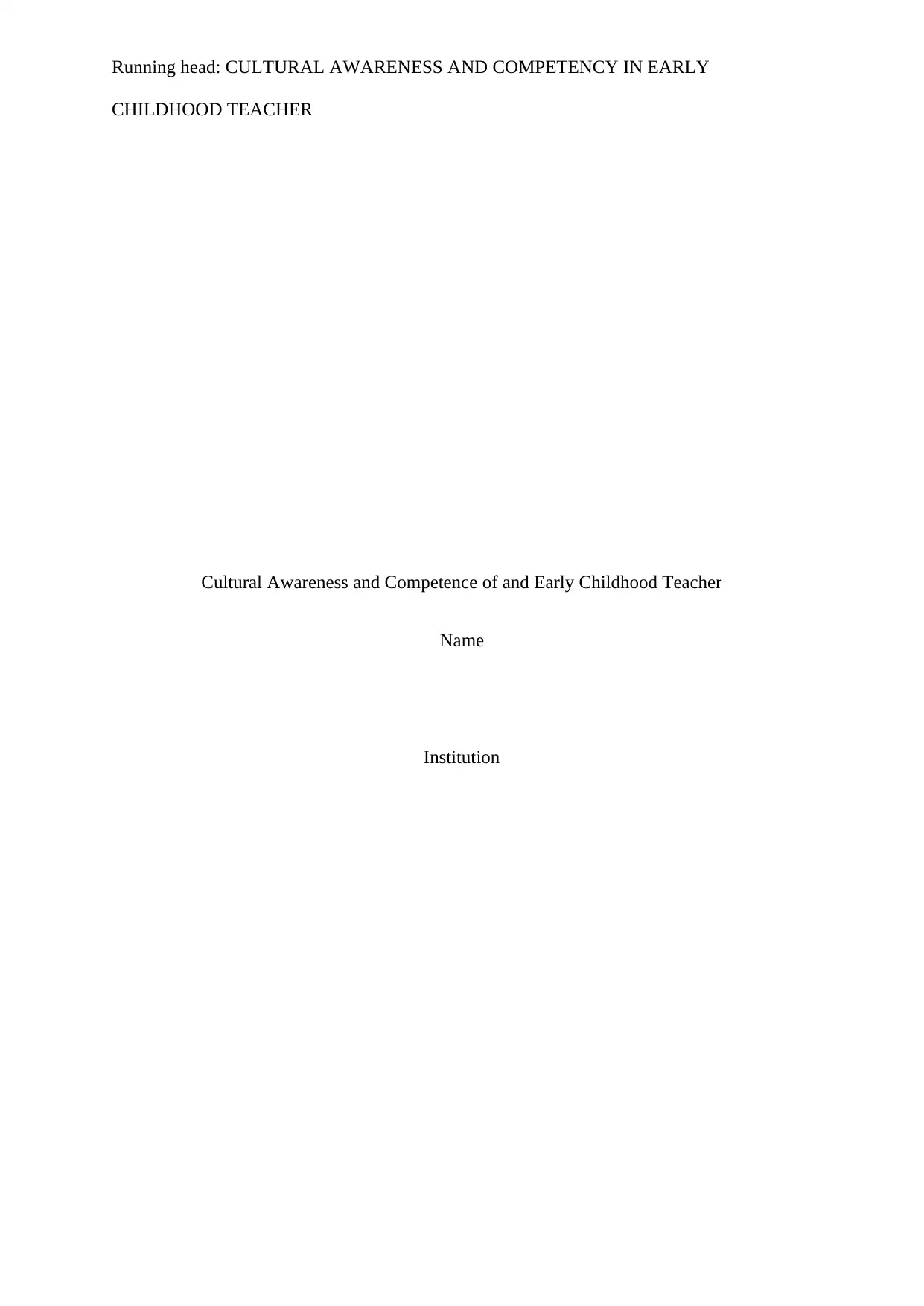
Running head: CULTURAL AWARENESS AND COMPETENCY IN EARLY
CHILDHOOD TEACHER
Cultural Awareness and Competence of and Early Childhood Teacher
Name
Institution
CHILDHOOD TEACHER
Cultural Awareness and Competence of and Early Childhood Teacher
Name
Institution
Paraphrase This Document
Need a fresh take? Get an instant paraphrase of this document with our AI Paraphraser
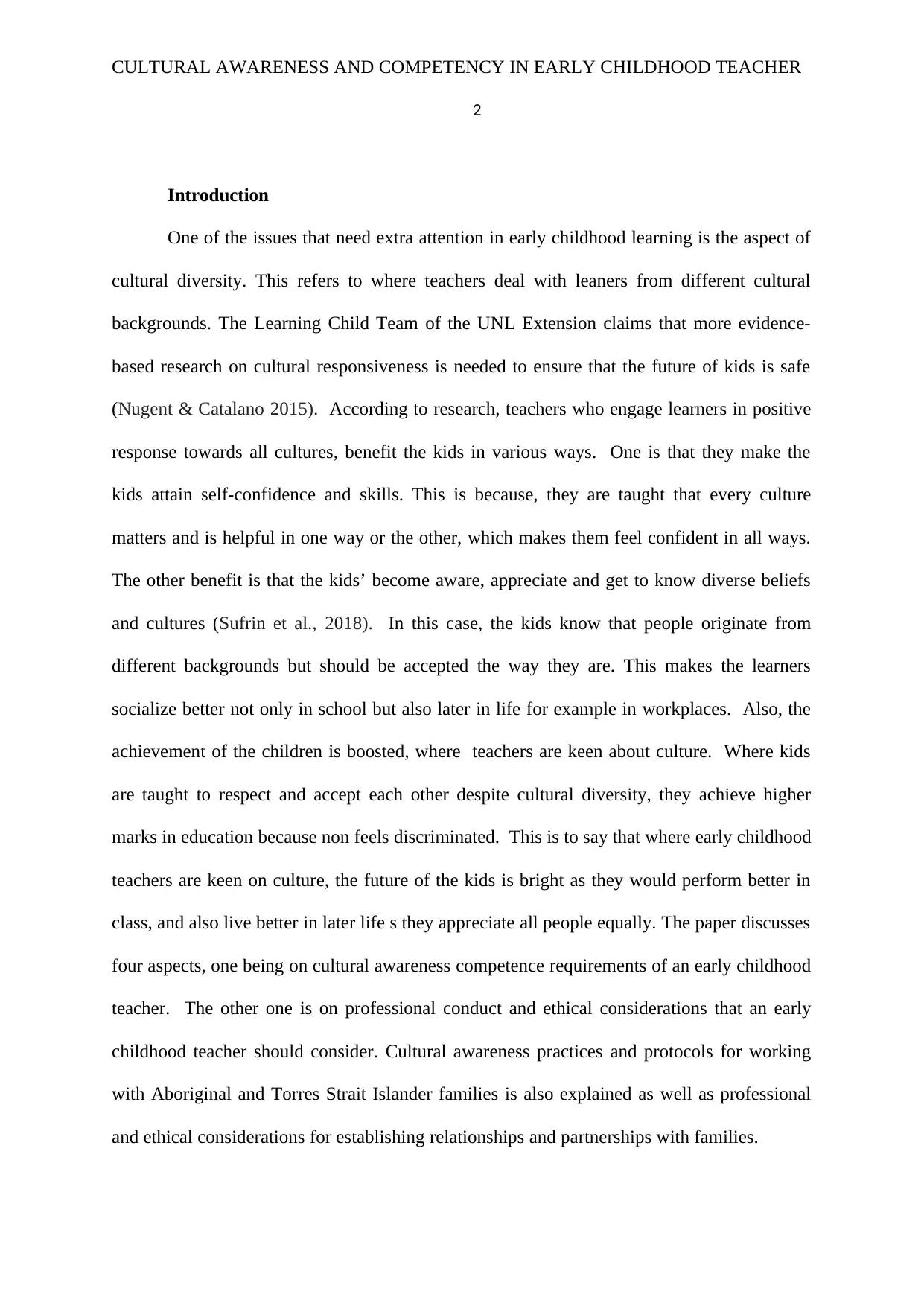
CULTURAL AWARENESS AND COMPETENCY IN EARLY CHILDHOOD TEACHER
2
Introduction
One of the issues that need extra attention in early childhood learning is the aspect of
cultural diversity. This refers to where teachers deal with leaners from different cultural
backgrounds. The Learning Child Team of the UNL Extension claims that more evidence-
based research on cultural responsiveness is needed to ensure that the future of kids is safe
(Nugent & Catalano 2015). According to research, teachers who engage learners in positive
response towards all cultures, benefit the kids in various ways. One is that they make the
kids attain self-confidence and skills. This is because, they are taught that every culture
matters and is helpful in one way or the other, which makes them feel confident in all ways.
The other benefit is that the kids’ become aware, appreciate and get to know diverse beliefs
and cultures (Sufrin et al., 2018). In this case, the kids know that people originate from
different backgrounds but should be accepted the way they are. This makes the learners
socialize better not only in school but also later in life for example in workplaces. Also, the
achievement of the children is boosted, where teachers are keen about culture. Where kids
are taught to respect and accept each other despite cultural diversity, they achieve higher
marks in education because non feels discriminated. This is to say that where early childhood
teachers are keen on culture, the future of the kids is bright as they would perform better in
class, and also live better in later life s they appreciate all people equally. The paper discusses
four aspects, one being on cultural awareness competence requirements of an early childhood
teacher. The other one is on professional conduct and ethical considerations that an early
childhood teacher should consider. Cultural awareness practices and protocols for working
with Aboriginal and Torres Strait Islander families is also explained as well as professional
and ethical considerations for establishing relationships and partnerships with families.
2
Introduction
One of the issues that need extra attention in early childhood learning is the aspect of
cultural diversity. This refers to where teachers deal with leaners from different cultural
backgrounds. The Learning Child Team of the UNL Extension claims that more evidence-
based research on cultural responsiveness is needed to ensure that the future of kids is safe
(Nugent & Catalano 2015). According to research, teachers who engage learners in positive
response towards all cultures, benefit the kids in various ways. One is that they make the
kids attain self-confidence and skills. This is because, they are taught that every culture
matters and is helpful in one way or the other, which makes them feel confident in all ways.
The other benefit is that the kids’ become aware, appreciate and get to know diverse beliefs
and cultures (Sufrin et al., 2018). In this case, the kids know that people originate from
different backgrounds but should be accepted the way they are. This makes the learners
socialize better not only in school but also later in life for example in workplaces. Also, the
achievement of the children is boosted, where teachers are keen about culture. Where kids
are taught to respect and accept each other despite cultural diversity, they achieve higher
marks in education because non feels discriminated. This is to say that where early childhood
teachers are keen on culture, the future of the kids is bright as they would perform better in
class, and also live better in later life s they appreciate all people equally. The paper discusses
four aspects, one being on cultural awareness competence requirements of an early childhood
teacher. The other one is on professional conduct and ethical considerations that an early
childhood teacher should consider. Cultural awareness practices and protocols for working
with Aboriginal and Torres Strait Islander families is also explained as well as professional
and ethical considerations for establishing relationships and partnerships with families.
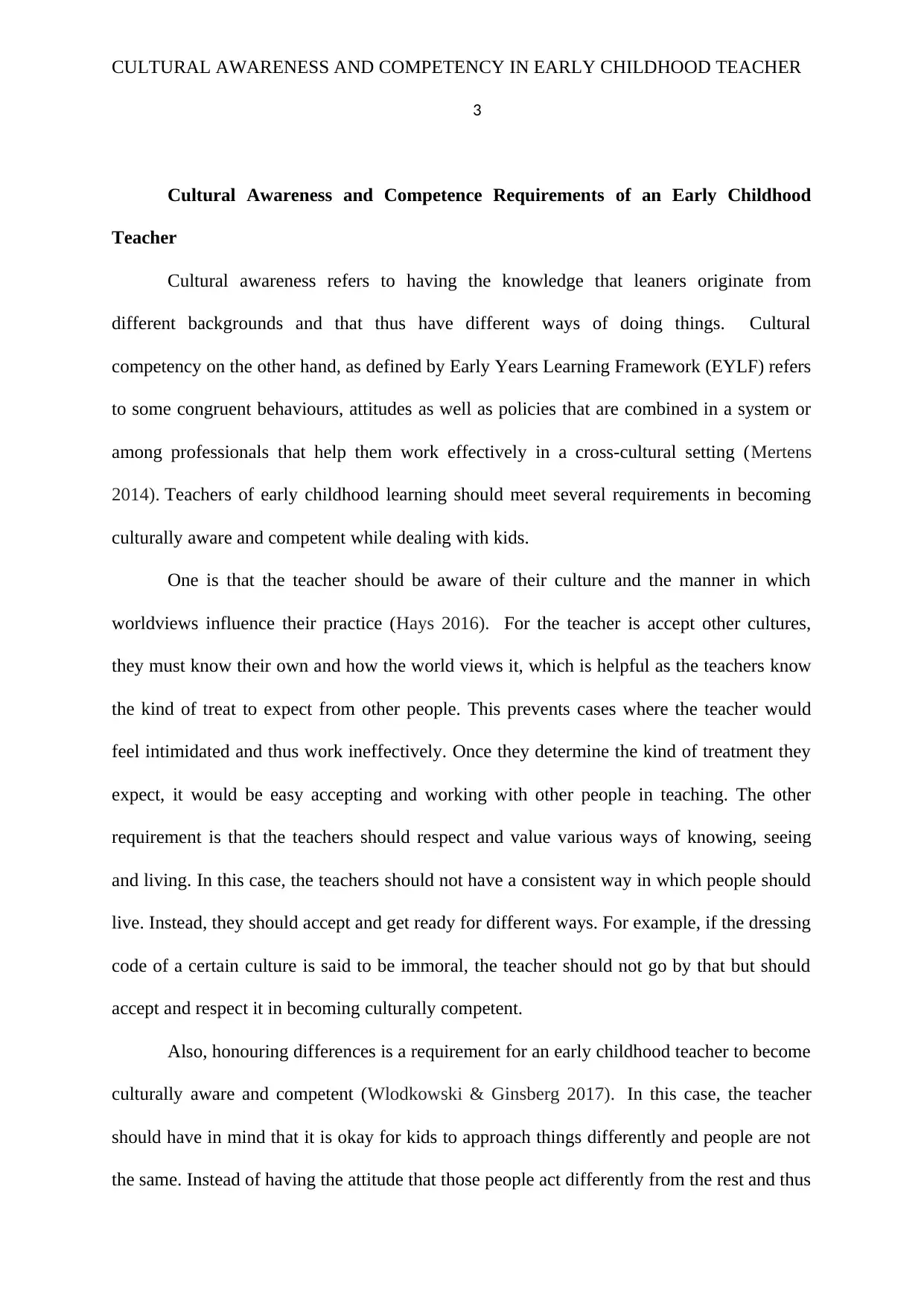
CULTURAL AWARENESS AND COMPETENCY IN EARLY CHILDHOOD TEACHER
3
Cultural Awareness and Competence Requirements of an Early Childhood
Teacher
Cultural awareness refers to having the knowledge that leaners originate from
different backgrounds and that thus have different ways of doing things. Cultural
competency on the other hand, as defined by Early Years Learning Framework (EYLF) refers
to some congruent behaviours, attitudes as well as policies that are combined in a system or
among professionals that help them work effectively in a cross-cultural setting (Mertens
2014). Teachers of early childhood learning should meet several requirements in becoming
culturally aware and competent while dealing with kids.
One is that the teacher should be aware of their culture and the manner in which
worldviews influence their practice (Hays 2016). For the teacher is accept other cultures,
they must know their own and how the world views it, which is helpful as the teachers know
the kind of treat to expect from other people. This prevents cases where the teacher would
feel intimidated and thus work ineffectively. Once they determine the kind of treatment they
expect, it would be easy accepting and working with other people in teaching. The other
requirement is that the teachers should respect and value various ways of knowing, seeing
and living. In this case, the teachers should not have a consistent way in which people should
live. Instead, they should accept and get ready for different ways. For example, if the dressing
code of a certain culture is said to be immoral, the teacher should not go by that but should
accept and respect it in becoming culturally competent.
Also, honouring differences is a requirement for an early childhood teacher to become
culturally aware and competent (Wlodkowski & Ginsberg 2017). In this case, the teacher
should have in mind that it is okay for kids to approach things differently and people are not
the same. Instead of having the attitude that those people act differently from the rest and thus
3
Cultural Awareness and Competence Requirements of an Early Childhood
Teacher
Cultural awareness refers to having the knowledge that leaners originate from
different backgrounds and that thus have different ways of doing things. Cultural
competency on the other hand, as defined by Early Years Learning Framework (EYLF) refers
to some congruent behaviours, attitudes as well as policies that are combined in a system or
among professionals that help them work effectively in a cross-cultural setting (Mertens
2014). Teachers of early childhood learning should meet several requirements in becoming
culturally aware and competent while dealing with kids.
One is that the teacher should be aware of their culture and the manner in which
worldviews influence their practice (Hays 2016). For the teacher is accept other cultures,
they must know their own and how the world views it, which is helpful as the teachers know
the kind of treat to expect from other people. This prevents cases where the teacher would
feel intimidated and thus work ineffectively. Once they determine the kind of treatment they
expect, it would be easy accepting and working with other people in teaching. The other
requirement is that the teachers should respect and value various ways of knowing, seeing
and living. In this case, the teachers should not have a consistent way in which people should
live. Instead, they should accept and get ready for different ways. For example, if the dressing
code of a certain culture is said to be immoral, the teacher should not go by that but should
accept and respect it in becoming culturally competent.
Also, honouring differences is a requirement for an early childhood teacher to become
culturally aware and competent (Wlodkowski & Ginsberg 2017). In this case, the teacher
should have in mind that it is okay for kids to approach things differently and people are not
the same. Instead of having the attitude that those people act differently from the rest and thus
⊘ This is a preview!⊘
Do you want full access?
Subscribe today to unlock all pages.

Trusted by 1+ million students worldwide
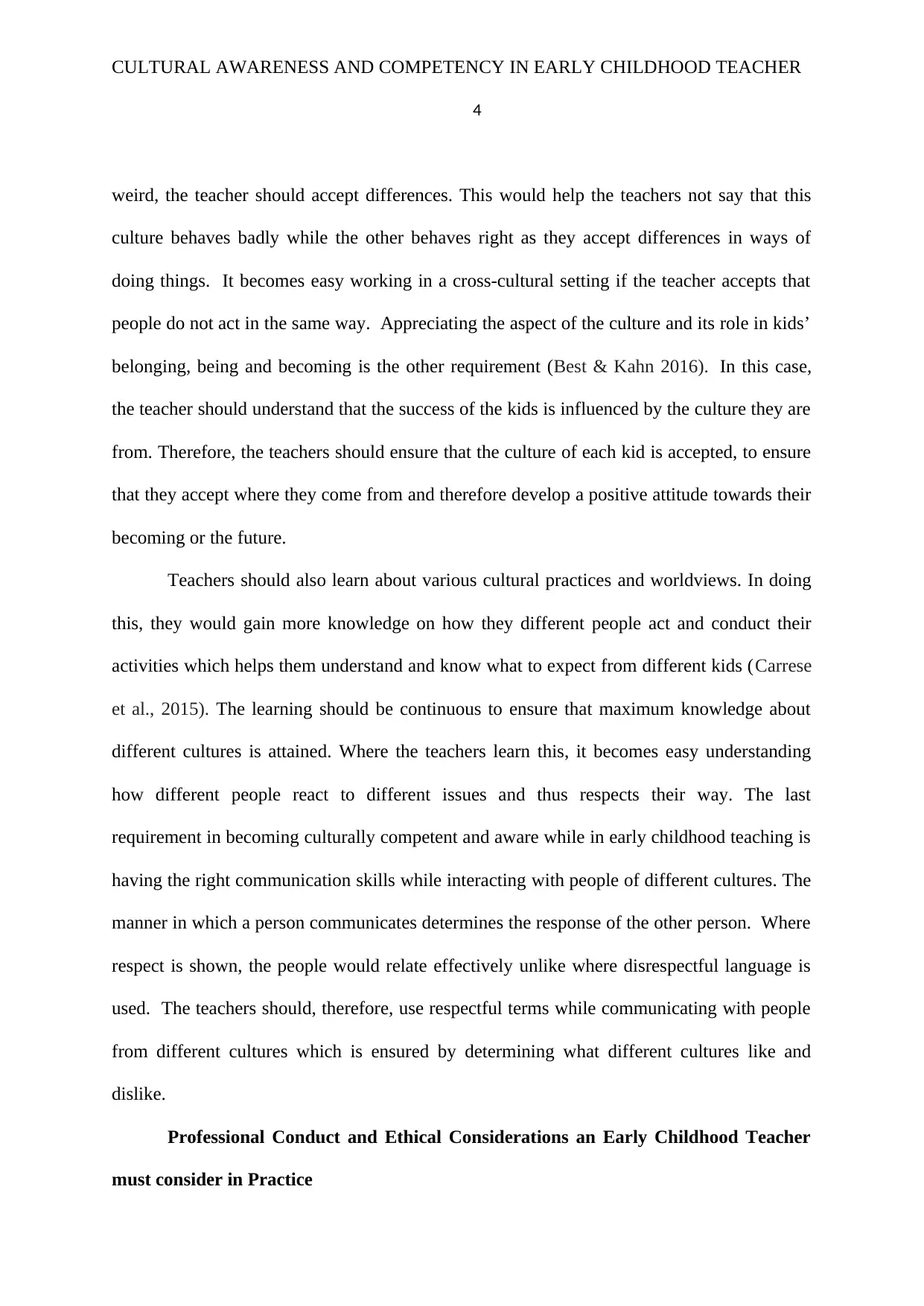
CULTURAL AWARENESS AND COMPETENCY IN EARLY CHILDHOOD TEACHER
4
weird, the teacher should accept differences. This would help the teachers not say that this
culture behaves badly while the other behaves right as they accept differences in ways of
doing things. It becomes easy working in a cross-cultural setting if the teacher accepts that
people do not act in the same way. Appreciating the aspect of the culture and its role in kids’
belonging, being and becoming is the other requirement (Best & Kahn 2016). In this case,
the teacher should understand that the success of the kids is influenced by the culture they are
from. Therefore, the teachers should ensure that the culture of each kid is accepted, to ensure
that they accept where they come from and therefore develop a positive attitude towards their
becoming or the future.
Teachers should also learn about various cultural practices and worldviews. In doing
this, they would gain more knowledge on how they different people act and conduct their
activities which helps them understand and know what to expect from different kids (Carrese
et al., 2015). The learning should be continuous to ensure that maximum knowledge about
different cultures is attained. Where the teachers learn this, it becomes easy understanding
how different people react to different issues and thus respects their way. The last
requirement in becoming culturally competent and aware while in early childhood teaching is
having the right communication skills while interacting with people of different cultures. The
manner in which a person communicates determines the response of the other person. Where
respect is shown, the people would relate effectively unlike where disrespectful language is
used. The teachers should, therefore, use respectful terms while communicating with people
from different cultures which is ensured by determining what different cultures like and
dislike.
Professional Conduct and Ethical Considerations an Early Childhood Teacher
must consider in Practice
4
weird, the teacher should accept differences. This would help the teachers not say that this
culture behaves badly while the other behaves right as they accept differences in ways of
doing things. It becomes easy working in a cross-cultural setting if the teacher accepts that
people do not act in the same way. Appreciating the aspect of the culture and its role in kids’
belonging, being and becoming is the other requirement (Best & Kahn 2016). In this case,
the teacher should understand that the success of the kids is influenced by the culture they are
from. Therefore, the teachers should ensure that the culture of each kid is accepted, to ensure
that they accept where they come from and therefore develop a positive attitude towards their
becoming or the future.
Teachers should also learn about various cultural practices and worldviews. In doing
this, they would gain more knowledge on how they different people act and conduct their
activities which helps them understand and know what to expect from different kids (Carrese
et al., 2015). The learning should be continuous to ensure that maximum knowledge about
different cultures is attained. Where the teachers learn this, it becomes easy understanding
how different people react to different issues and thus respects their way. The last
requirement in becoming culturally competent and aware while in early childhood teaching is
having the right communication skills while interacting with people of different cultures. The
manner in which a person communicates determines the response of the other person. Where
respect is shown, the people would relate effectively unlike where disrespectful language is
used. The teachers should, therefore, use respectful terms while communicating with people
from different cultures which is ensured by determining what different cultures like and
dislike.
Professional Conduct and Ethical Considerations an Early Childhood Teacher
must consider in Practice
Paraphrase This Document
Need a fresh take? Get an instant paraphrase of this document with our AI Paraphraser
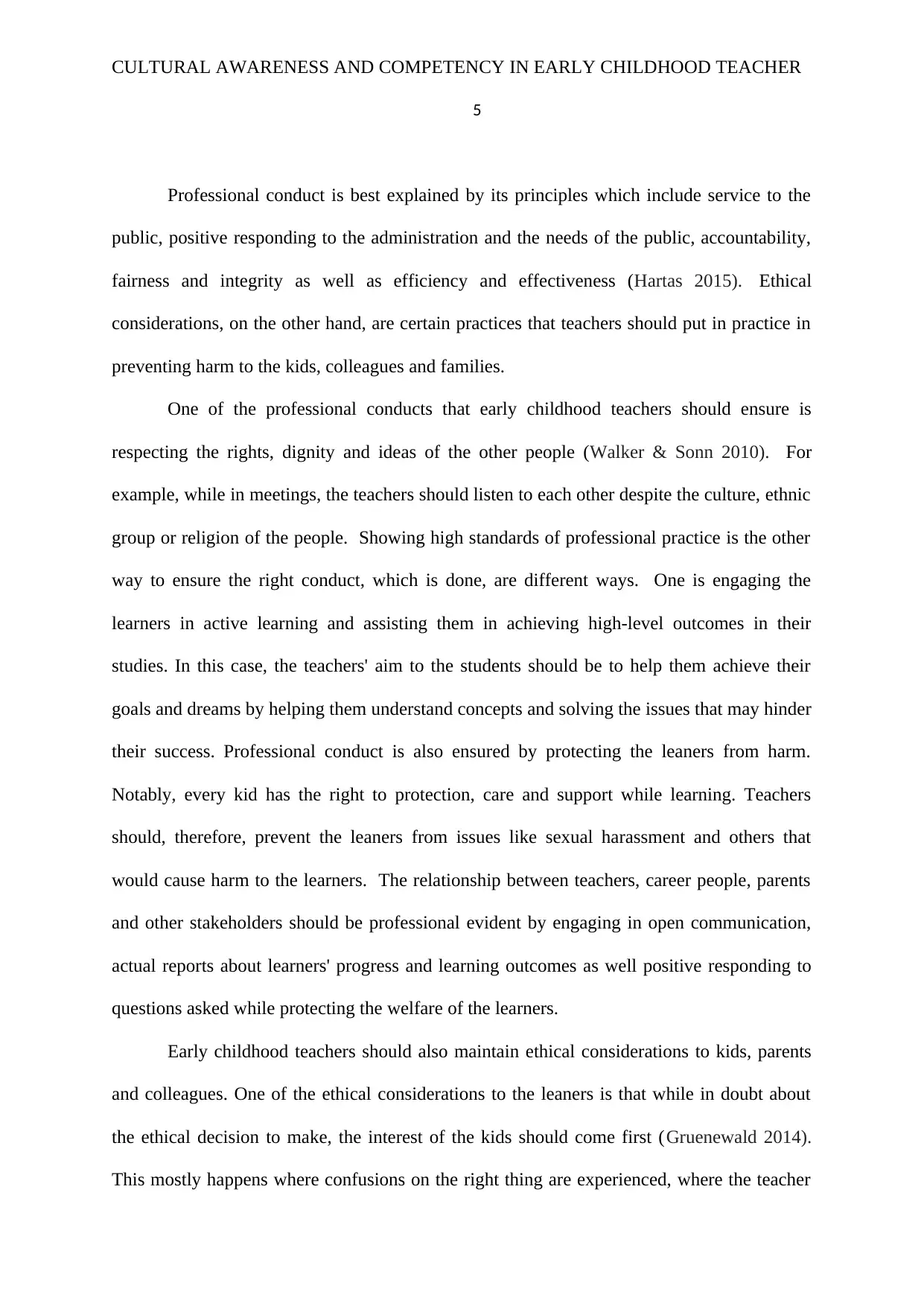
CULTURAL AWARENESS AND COMPETENCY IN EARLY CHILDHOOD TEACHER
5
Professional conduct is best explained by its principles which include service to the
public, positive responding to the administration and the needs of the public, accountability,
fairness and integrity as well as efficiency and effectiveness (Hartas 2015). Ethical
considerations, on the other hand, are certain practices that teachers should put in practice in
preventing harm to the kids, colleagues and families.
One of the professional conducts that early childhood teachers should ensure is
respecting the rights, dignity and ideas of the other people (Walker & Sonn 2010). For
example, while in meetings, the teachers should listen to each other despite the culture, ethnic
group or religion of the people. Showing high standards of professional practice is the other
way to ensure the right conduct, which is done, are different ways. One is engaging the
learners in active learning and assisting them in achieving high-level outcomes in their
studies. In this case, the teachers' aim to the students should be to help them achieve their
goals and dreams by helping them understand concepts and solving the issues that may hinder
their success. Professional conduct is also ensured by protecting the leaners from harm.
Notably, every kid has the right to protection, care and support while learning. Teachers
should, therefore, prevent the leaners from issues like sexual harassment and others that
would cause harm to the learners. The relationship between teachers, career people, parents
and other stakeholders should be professional evident by engaging in open communication,
actual reports about learners' progress and learning outcomes as well positive responding to
questions asked while protecting the welfare of the learners.
Early childhood teachers should also maintain ethical considerations to kids, parents
and colleagues. One of the ethical considerations to the leaners is that while in doubt about
the ethical decision to make, the interest of the kids should come first (Gruenewald 2014).
This mostly happens where confusions on the right thing are experienced, where the teacher
5
Professional conduct is best explained by its principles which include service to the
public, positive responding to the administration and the needs of the public, accountability,
fairness and integrity as well as efficiency and effectiveness (Hartas 2015). Ethical
considerations, on the other hand, are certain practices that teachers should put in practice in
preventing harm to the kids, colleagues and families.
One of the professional conducts that early childhood teachers should ensure is
respecting the rights, dignity and ideas of the other people (Walker & Sonn 2010). For
example, while in meetings, the teachers should listen to each other despite the culture, ethnic
group or religion of the people. Showing high standards of professional practice is the other
way to ensure the right conduct, which is done, are different ways. One is engaging the
learners in active learning and assisting them in achieving high-level outcomes in their
studies. In this case, the teachers' aim to the students should be to help them achieve their
goals and dreams by helping them understand concepts and solving the issues that may hinder
their success. Professional conduct is also ensured by protecting the leaners from harm.
Notably, every kid has the right to protection, care and support while learning. Teachers
should, therefore, prevent the leaners from issues like sexual harassment and others that
would cause harm to the learners. The relationship between teachers, career people, parents
and other stakeholders should be professional evident by engaging in open communication,
actual reports about learners' progress and learning outcomes as well positive responding to
questions asked while protecting the welfare of the learners.
Early childhood teachers should also maintain ethical considerations to kids, parents
and colleagues. One of the ethical considerations to the leaners is that while in doubt about
the ethical decision to make, the interest of the kids should come first (Gruenewald 2014).
This mostly happens where confusions on the right thing are experienced, where the teacher
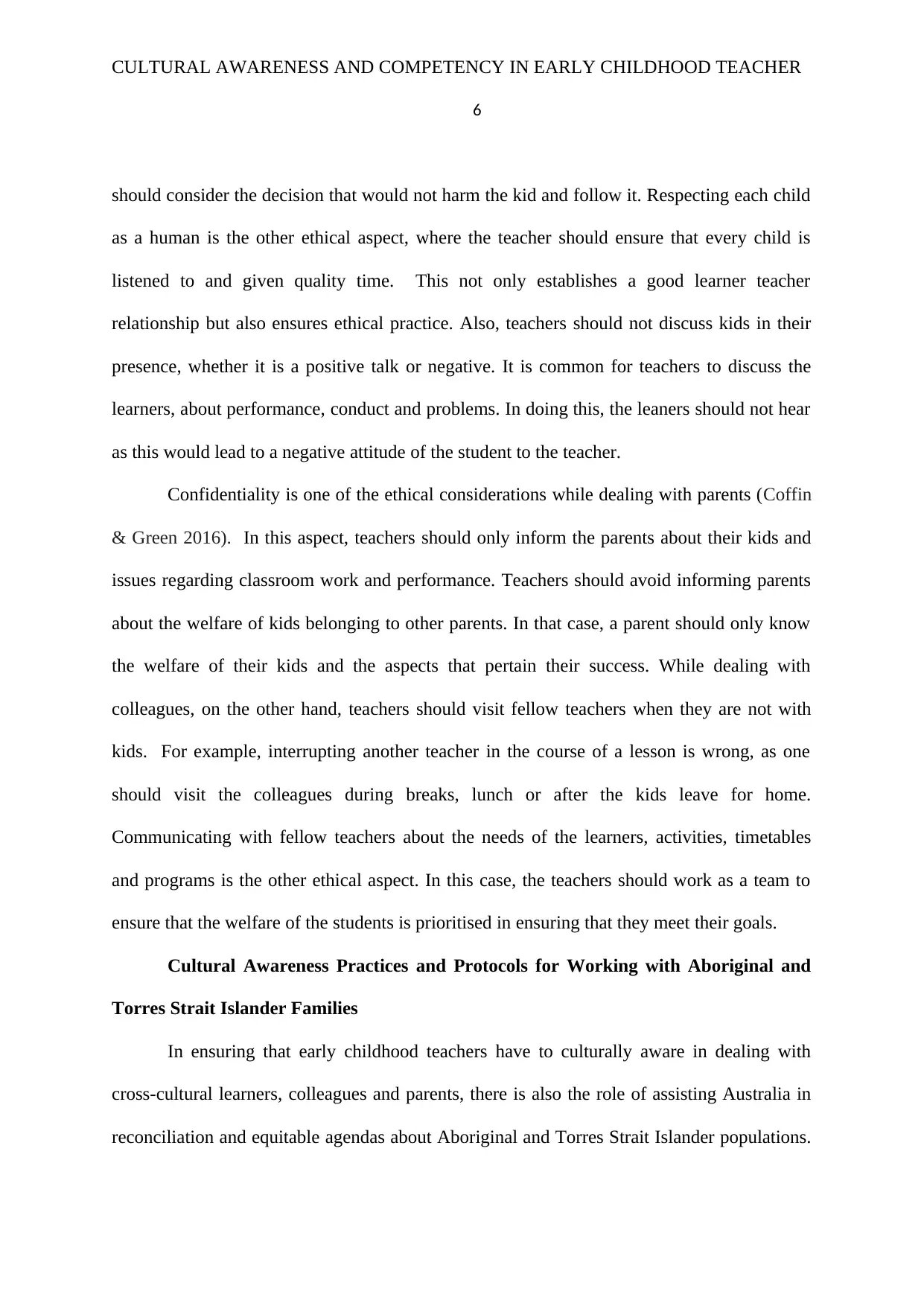
CULTURAL AWARENESS AND COMPETENCY IN EARLY CHILDHOOD TEACHER
6
should consider the decision that would not harm the kid and follow it. Respecting each child
as a human is the other ethical aspect, where the teacher should ensure that every child is
listened to and given quality time. This not only establishes a good learner teacher
relationship but also ensures ethical practice. Also, teachers should not discuss kids in their
presence, whether it is a positive talk or negative. It is common for teachers to discuss the
learners, about performance, conduct and problems. In doing this, the leaners should not hear
as this would lead to a negative attitude of the student to the teacher.
Confidentiality is one of the ethical considerations while dealing with parents (Coffin
& Green 2016). In this aspect, teachers should only inform the parents about their kids and
issues regarding classroom work and performance. Teachers should avoid informing parents
about the welfare of kids belonging to other parents. In that case, a parent should only know
the welfare of their kids and the aspects that pertain their success. While dealing with
colleagues, on the other hand, teachers should visit fellow teachers when they are not with
kids. For example, interrupting another teacher in the course of a lesson is wrong, as one
should visit the colleagues during breaks, lunch or after the kids leave for home.
Communicating with fellow teachers about the needs of the learners, activities, timetables
and programs is the other ethical aspect. In this case, the teachers should work as a team to
ensure that the welfare of the students is prioritised in ensuring that they meet their goals.
Cultural Awareness Practices and Protocols for Working with Aboriginal and
Torres Strait Islander Families
In ensuring that early childhood teachers have to culturally aware in dealing with
cross-cultural learners, colleagues and parents, there is also the role of assisting Australia in
reconciliation and equitable agendas about Aboriginal and Torres Strait Islander populations.
6
should consider the decision that would not harm the kid and follow it. Respecting each child
as a human is the other ethical aspect, where the teacher should ensure that every child is
listened to and given quality time. This not only establishes a good learner teacher
relationship but also ensures ethical practice. Also, teachers should not discuss kids in their
presence, whether it is a positive talk or negative. It is common for teachers to discuss the
learners, about performance, conduct and problems. In doing this, the leaners should not hear
as this would lead to a negative attitude of the student to the teacher.
Confidentiality is one of the ethical considerations while dealing with parents (Coffin
& Green 2016). In this aspect, teachers should only inform the parents about their kids and
issues regarding classroom work and performance. Teachers should avoid informing parents
about the welfare of kids belonging to other parents. In that case, a parent should only know
the welfare of their kids and the aspects that pertain their success. While dealing with
colleagues, on the other hand, teachers should visit fellow teachers when they are not with
kids. For example, interrupting another teacher in the course of a lesson is wrong, as one
should visit the colleagues during breaks, lunch or after the kids leave for home.
Communicating with fellow teachers about the needs of the learners, activities, timetables
and programs is the other ethical aspect. In this case, the teachers should work as a team to
ensure that the welfare of the students is prioritised in ensuring that they meet their goals.
Cultural Awareness Practices and Protocols for Working with Aboriginal and
Torres Strait Islander Families
In ensuring that early childhood teachers have to culturally aware in dealing with
cross-cultural learners, colleagues and parents, there is also the role of assisting Australia in
reconciliation and equitable agendas about Aboriginal and Torres Strait Islander populations.
⊘ This is a preview!⊘
Do you want full access?
Subscribe today to unlock all pages.

Trusted by 1+ million students worldwide
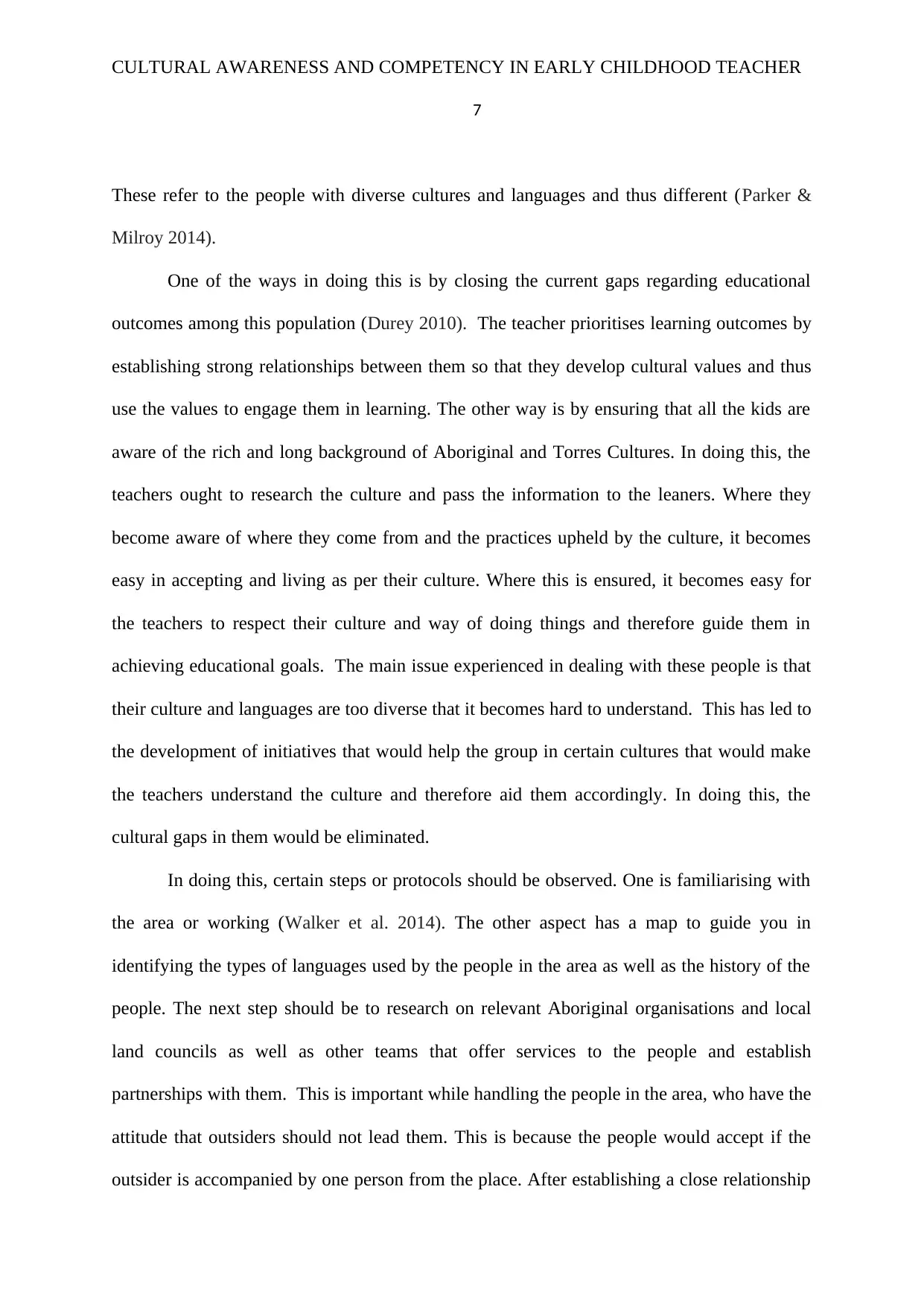
CULTURAL AWARENESS AND COMPETENCY IN EARLY CHILDHOOD TEACHER
7
These refer to the people with diverse cultures and languages and thus different (Parker &
Milroy 2014).
One of the ways in doing this is by closing the current gaps regarding educational
outcomes among this population (Durey 2010). The teacher prioritises learning outcomes by
establishing strong relationships between them so that they develop cultural values and thus
use the values to engage them in learning. The other way is by ensuring that all the kids are
aware of the rich and long background of Aboriginal and Torres Cultures. In doing this, the
teachers ought to research the culture and pass the information to the leaners. Where they
become aware of where they come from and the practices upheld by the culture, it becomes
easy in accepting and living as per their culture. Where this is ensured, it becomes easy for
the teachers to respect their culture and way of doing things and therefore guide them in
achieving educational goals. The main issue experienced in dealing with these people is that
their culture and languages are too diverse that it becomes hard to understand. This has led to
the development of initiatives that would help the group in certain cultures that would make
the teachers understand the culture and therefore aid them accordingly. In doing this, the
cultural gaps in them would be eliminated.
In doing this, certain steps or protocols should be observed. One is familiarising with
the area or working (Walker et al. 2014). The other aspect has a map to guide you in
identifying the types of languages used by the people in the area as well as the history of the
people. The next step should be to research on relevant Aboriginal organisations and local
land councils as well as other teams that offer services to the people and establish
partnerships with them. This is important while handling the people in the area, who have the
attitude that outsiders should not lead them. This is because the people would accept if the
outsider is accompanied by one person from the place. After establishing a close relationship
7
These refer to the people with diverse cultures and languages and thus different (Parker &
Milroy 2014).
One of the ways in doing this is by closing the current gaps regarding educational
outcomes among this population (Durey 2010). The teacher prioritises learning outcomes by
establishing strong relationships between them so that they develop cultural values and thus
use the values to engage them in learning. The other way is by ensuring that all the kids are
aware of the rich and long background of Aboriginal and Torres Cultures. In doing this, the
teachers ought to research the culture and pass the information to the leaners. Where they
become aware of where they come from and the practices upheld by the culture, it becomes
easy in accepting and living as per their culture. Where this is ensured, it becomes easy for
the teachers to respect their culture and way of doing things and therefore guide them in
achieving educational goals. The main issue experienced in dealing with these people is that
their culture and languages are too diverse that it becomes hard to understand. This has led to
the development of initiatives that would help the group in certain cultures that would make
the teachers understand the culture and therefore aid them accordingly. In doing this, the
cultural gaps in them would be eliminated.
In doing this, certain steps or protocols should be observed. One is familiarising with
the area or working (Walker et al. 2014). The other aspect has a map to guide you in
identifying the types of languages used by the people in the area as well as the history of the
people. The next step should be to research on relevant Aboriginal organisations and local
land councils as well as other teams that offer services to the people and establish
partnerships with them. This is important while handling the people in the area, who have the
attitude that outsiders should not lead them. This is because the people would accept if the
outsider is accompanied by one person from the place. After establishing a close relationship
Paraphrase This Document
Need a fresh take? Get an instant paraphrase of this document with our AI Paraphraser
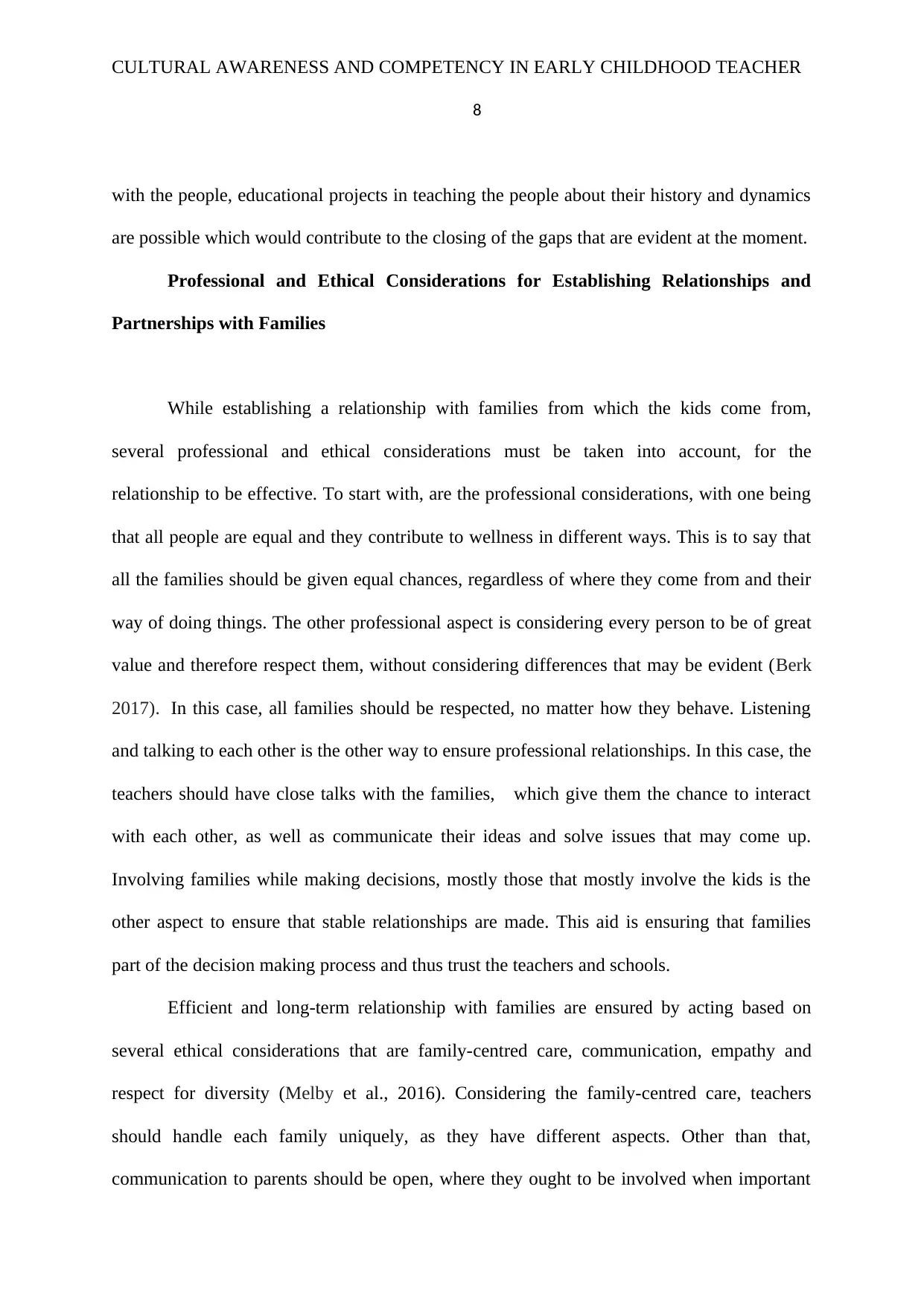
CULTURAL AWARENESS AND COMPETENCY IN EARLY CHILDHOOD TEACHER
8
with the people, educational projects in teaching the people about their history and dynamics
are possible which would contribute to the closing of the gaps that are evident at the moment.
Professional and Ethical Considerations for Establishing Relationships and
Partnerships with Families
While establishing a relationship with families from which the kids come from,
several professional and ethical considerations must be taken into account, for the
relationship to be effective. To start with, are the professional considerations, with one being
that all people are equal and they contribute to wellness in different ways. This is to say that
all the families should be given equal chances, regardless of where they come from and their
way of doing things. The other professional aspect is considering every person to be of great
value and therefore respect them, without considering differences that may be evident (Berk
2017). In this case, all families should be respected, no matter how they behave. Listening
and talking to each other is the other way to ensure professional relationships. In this case, the
teachers should have close talks with the families, which give them the chance to interact
with each other, as well as communicate their ideas and solve issues that may come up.
Involving families while making decisions, mostly those that mostly involve the kids is the
other aspect to ensure that stable relationships are made. This aid is ensuring that families
part of the decision making process and thus trust the teachers and schools.
Efficient and long-term relationship with families are ensured by acting based on
several ethical considerations that are family-centred care, communication, empathy and
respect for diversity (Melby et al., 2016). Considering the family-centred care, teachers
should handle each family uniquely, as they have different aspects. Other than that,
communication to parents should be open, where they ought to be involved when important
8
with the people, educational projects in teaching the people about their history and dynamics
are possible which would contribute to the closing of the gaps that are evident at the moment.
Professional and Ethical Considerations for Establishing Relationships and
Partnerships with Families
While establishing a relationship with families from which the kids come from,
several professional and ethical considerations must be taken into account, for the
relationship to be effective. To start with, are the professional considerations, with one being
that all people are equal and they contribute to wellness in different ways. This is to say that
all the families should be given equal chances, regardless of where they come from and their
way of doing things. The other professional aspect is considering every person to be of great
value and therefore respect them, without considering differences that may be evident (Berk
2017). In this case, all families should be respected, no matter how they behave. Listening
and talking to each other is the other way to ensure professional relationships. In this case, the
teachers should have close talks with the families, which give them the chance to interact
with each other, as well as communicate their ideas and solve issues that may come up.
Involving families while making decisions, mostly those that mostly involve the kids is the
other aspect to ensure that stable relationships are made. This aid is ensuring that families
part of the decision making process and thus trust the teachers and schools.
Efficient and long-term relationship with families are ensured by acting based on
several ethical considerations that are family-centred care, communication, empathy and
respect for diversity (Melby et al., 2016). Considering the family-centred care, teachers
should handle each family uniquely, as they have different aspects. Other than that,
communication to parents should be open, where they ought to be involved when important
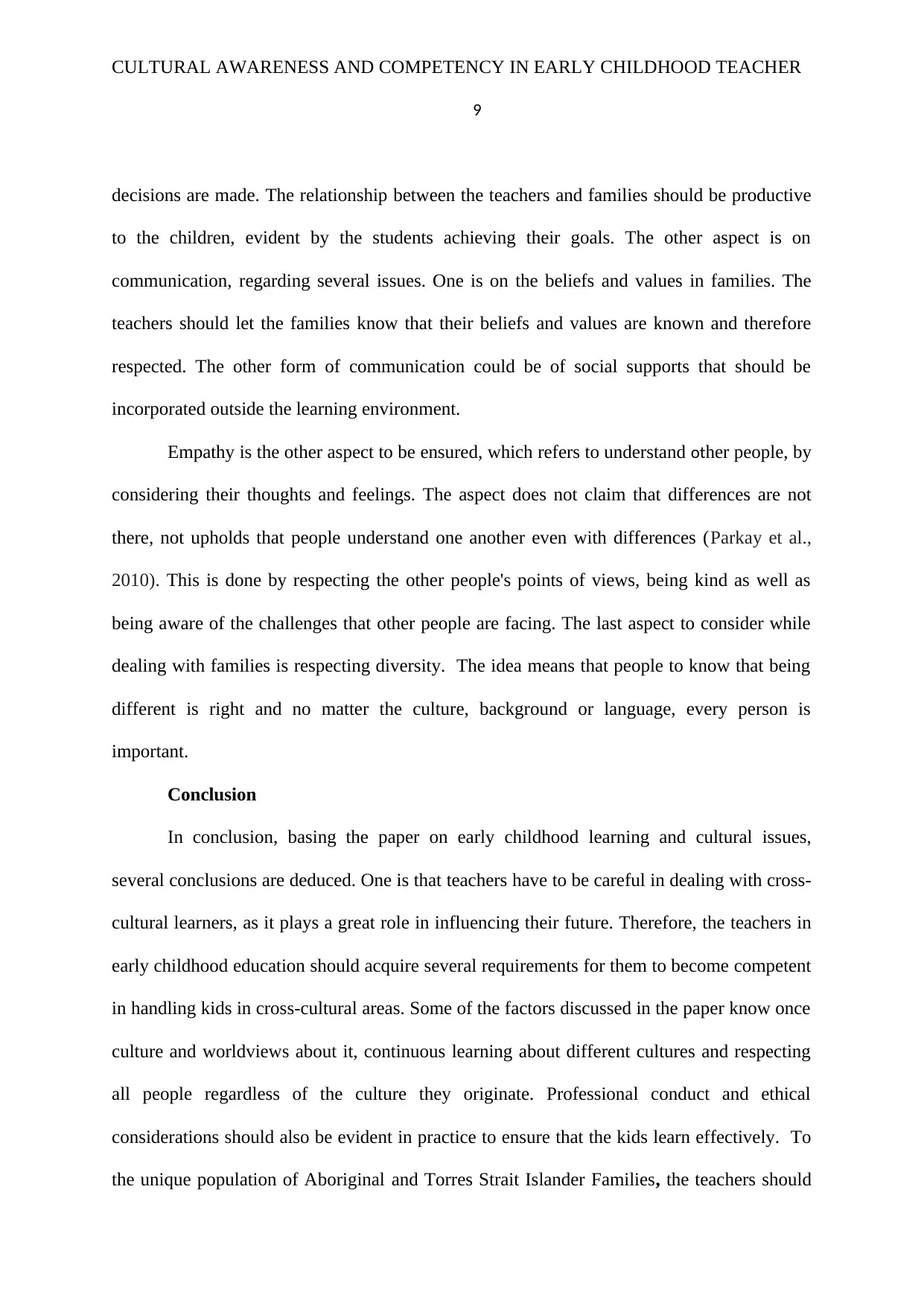
CULTURAL AWARENESS AND COMPETENCY IN EARLY CHILDHOOD TEACHER
9
decisions are made. The relationship between the teachers and families should be productive
to the children, evident by the students achieving their goals. The other aspect is on
communication, regarding several issues. One is on the beliefs and values in families. The
teachers should let the families know that their beliefs and values are known and therefore
respected. The other form of communication could be of social supports that should be
incorporated outside the learning environment.
Empathy is the other aspect to be ensured, which refers to understand other people, by
considering their thoughts and feelings. The aspect does not claim that differences are not
there, not upholds that people understand one another even with differences (Parkay et al.,
2010). This is done by respecting the other people's points of views, being kind as well as
being aware of the challenges that other people are facing. The last aspect to consider while
dealing with families is respecting diversity. The idea means that people to know that being
different is right and no matter the culture, background or language, every person is
important.
Conclusion
In conclusion, basing the paper on early childhood learning and cultural issues,
several conclusions are deduced. One is that teachers have to be careful in dealing with cross-
cultural learners, as it plays a great role in influencing their future. Therefore, the teachers in
early childhood education should acquire several requirements for them to become competent
in handling kids in cross-cultural areas. Some of the factors discussed in the paper know once
culture and worldviews about it, continuous learning about different cultures and respecting
all people regardless of the culture they originate. Professional conduct and ethical
considerations should also be evident in practice to ensure that the kids learn effectively. To
the unique population of Aboriginal and Torres Strait Islander Families, the teachers should
9
decisions are made. The relationship between the teachers and families should be productive
to the children, evident by the students achieving their goals. The other aspect is on
communication, regarding several issues. One is on the beliefs and values in families. The
teachers should let the families know that their beliefs and values are known and therefore
respected. The other form of communication could be of social supports that should be
incorporated outside the learning environment.
Empathy is the other aspect to be ensured, which refers to understand other people, by
considering their thoughts and feelings. The aspect does not claim that differences are not
there, not upholds that people understand one another even with differences (Parkay et al.,
2010). This is done by respecting the other people's points of views, being kind as well as
being aware of the challenges that other people are facing. The last aspect to consider while
dealing with families is respecting diversity. The idea means that people to know that being
different is right and no matter the culture, background or language, every person is
important.
Conclusion
In conclusion, basing the paper on early childhood learning and cultural issues,
several conclusions are deduced. One is that teachers have to be careful in dealing with cross-
cultural learners, as it plays a great role in influencing their future. Therefore, the teachers in
early childhood education should acquire several requirements for them to become competent
in handling kids in cross-cultural areas. Some of the factors discussed in the paper know once
culture and worldviews about it, continuous learning about different cultures and respecting
all people regardless of the culture they originate. Professional conduct and ethical
considerations should also be evident in practice to ensure that the kids learn effectively. To
the unique population of Aboriginal and Torres Strait Islander Families, the teachers should
⊘ This is a preview!⊘
Do you want full access?
Subscribe today to unlock all pages.

Trusted by 1+ million students worldwide
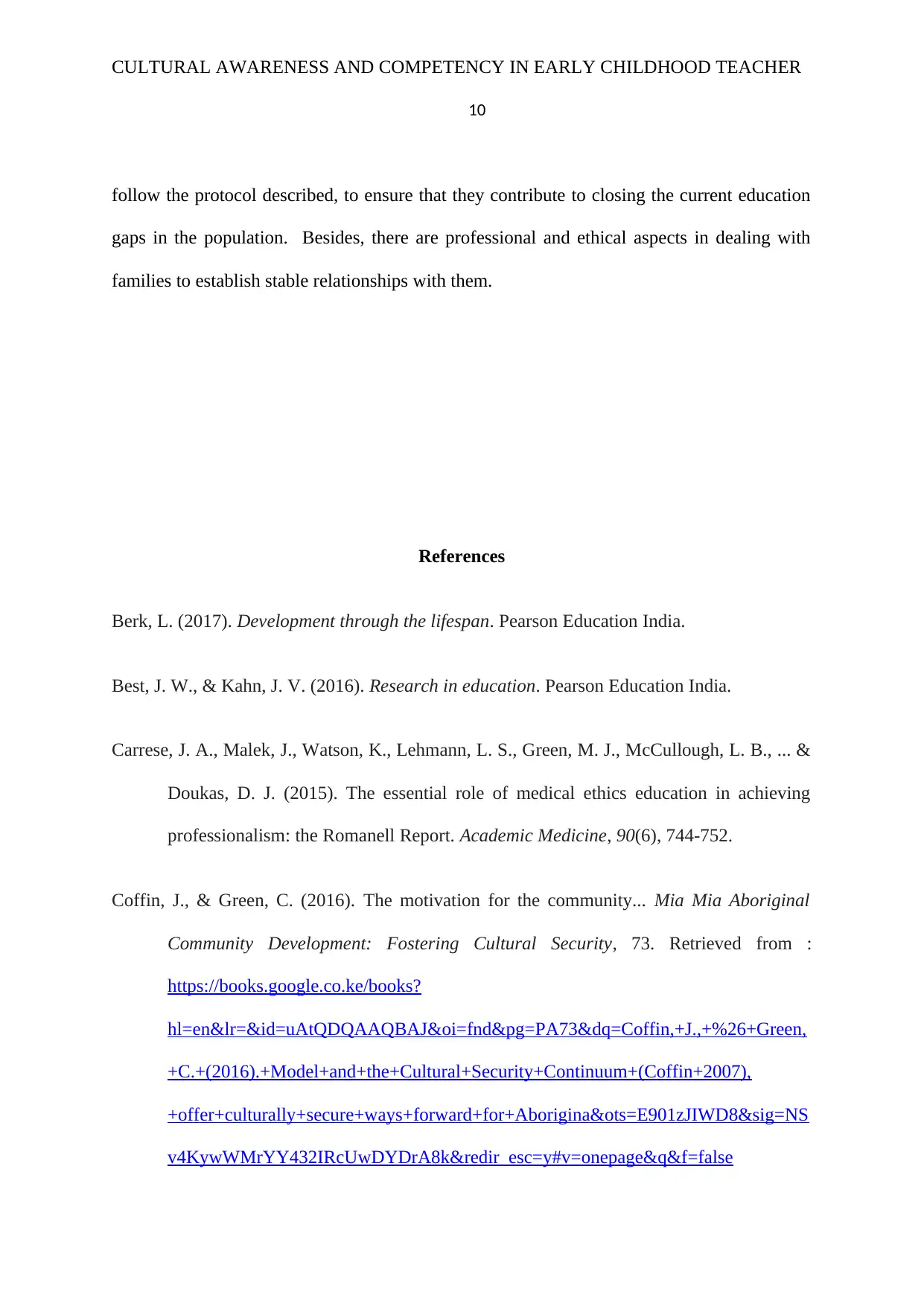
CULTURAL AWARENESS AND COMPETENCY IN EARLY CHILDHOOD TEACHER
10
follow the protocol described, to ensure that they contribute to closing the current education
gaps in the population. Besides, there are professional and ethical aspects in dealing with
families to establish stable relationships with them.
References
Berk, L. (2017). Development through the lifespan. Pearson Education India.
Best, J. W., & Kahn, J. V. (2016). Research in education. Pearson Education India.
Carrese, J. A., Malek, J., Watson, K., Lehmann, L. S., Green, M. J., McCullough, L. B., ... &
Doukas, D. J. (2015). The essential role of medical ethics education in achieving
professionalism: the Romanell Report. Academic Medicine, 90(6), 744-752.
Coffin, J., & Green, C. (2016). The motivation for the community... Mia Mia Aboriginal
Community Development: Fostering Cultural Security, 73. Retrieved from :
https://books.google.co.ke/books?
hl=en&lr=&id=uAtQDQAAQBAJ&oi=fnd&pg=PA73&dq=Coffin,+J.,+%26+Green,
+C.+(2016).+Model+and+the+Cultural+Security+Continuum+(Coffin+2007),
+offer+culturally+secure+ways+forward+for+Aborigina&ots=E901zJIWD8&sig=NS
v4KywWMrYY432IRcUwDYDrA8k&redir_esc=y#v=onepage&q&f=false
10
follow the protocol described, to ensure that they contribute to closing the current education
gaps in the population. Besides, there are professional and ethical aspects in dealing with
families to establish stable relationships with them.
References
Berk, L. (2017). Development through the lifespan. Pearson Education India.
Best, J. W., & Kahn, J. V. (2016). Research in education. Pearson Education India.
Carrese, J. A., Malek, J., Watson, K., Lehmann, L. S., Green, M. J., McCullough, L. B., ... &
Doukas, D. J. (2015). The essential role of medical ethics education in achieving
professionalism: the Romanell Report. Academic Medicine, 90(6), 744-752.
Coffin, J., & Green, C. (2016). The motivation for the community... Mia Mia Aboriginal
Community Development: Fostering Cultural Security, 73. Retrieved from :
https://books.google.co.ke/books?
hl=en&lr=&id=uAtQDQAAQBAJ&oi=fnd&pg=PA73&dq=Coffin,+J.,+%26+Green,
+C.+(2016).+Model+and+the+Cultural+Security+Continuum+(Coffin+2007),
+offer+culturally+secure+ways+forward+for+Aborigina&ots=E901zJIWD8&sig=NS
v4KywWMrYY432IRcUwDYDrA8k&redir_esc=y#v=onepage&q&f=false
Paraphrase This Document
Need a fresh take? Get an instant paraphrase of this document with our AI Paraphraser
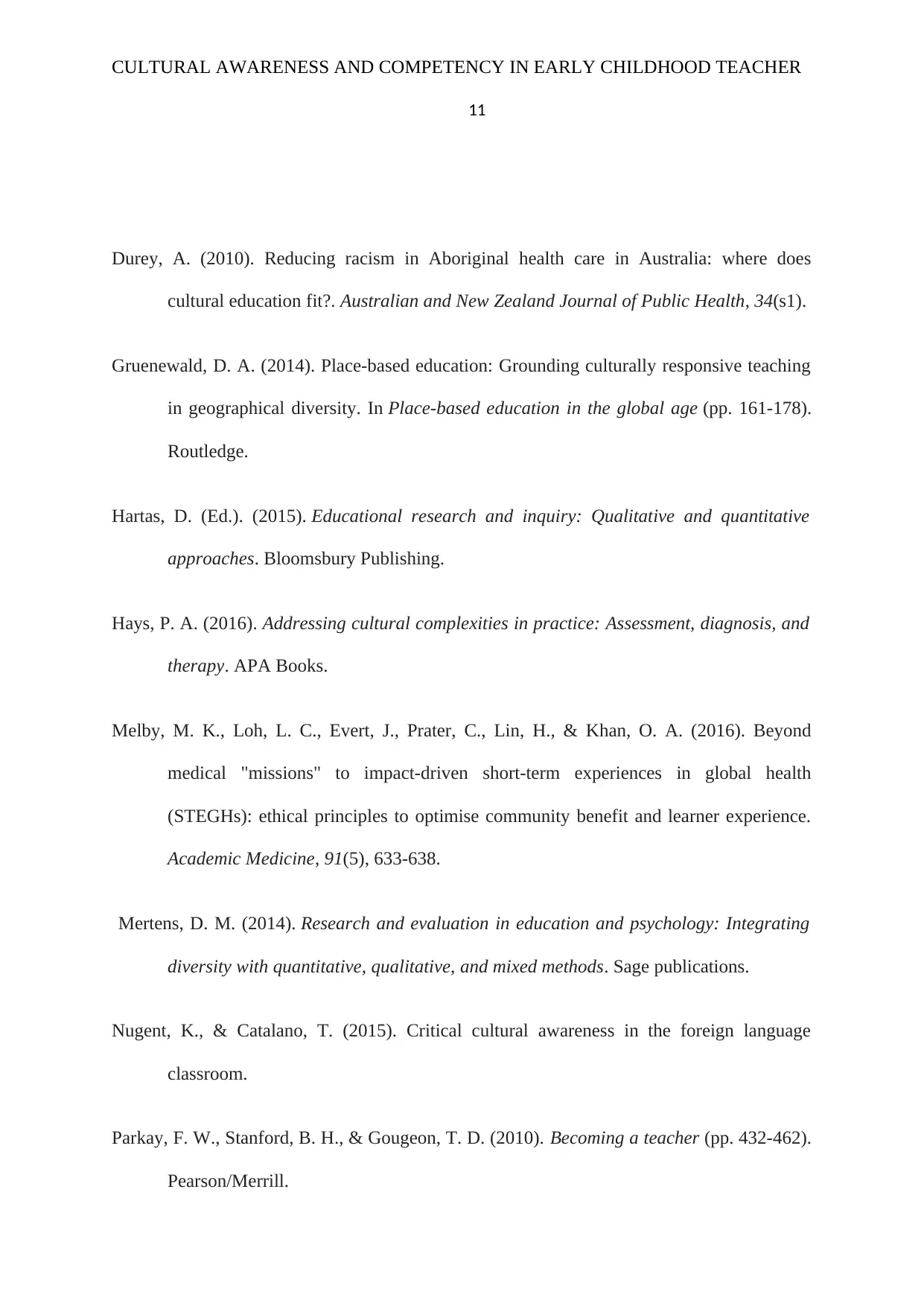
CULTURAL AWARENESS AND COMPETENCY IN EARLY CHILDHOOD TEACHER
11
Durey, A. (2010). Reducing racism in Aboriginal health care in Australia: where does
cultural education fit?. Australian and New Zealand Journal of Public Health, 34(s1).
Gruenewald, D. A. (2014). Place-based education: Grounding culturally responsive teaching
in geographical diversity. In Place-based education in the global age (pp. 161-178).
Routledge.
Hartas, D. (Ed.). (2015). Educational research and inquiry: Qualitative and quantitative
approaches. Bloomsbury Publishing.
Hays, P. A. (2016). Addressing cultural complexities in practice: Assessment, diagnosis, and
therapy. APA Books.
Melby, M. K., Loh, L. C., Evert, J., Prater, C., Lin, H., & Khan, O. A. (2016). Beyond
medical "missions" to impact-driven short-term experiences in global health
(STEGHs): ethical principles to optimise community benefit and learner experience.
Academic Medicine, 91(5), 633-638.
Mertens, D. M. (2014). Research and evaluation in education and psychology: Integrating
diversity with quantitative, qualitative, and mixed methods. Sage publications.
Nugent, K., & Catalano, T. (2015). Critical cultural awareness in the foreign language
classroom.
Parkay, F. W., Stanford, B. H., & Gougeon, T. D. (2010). Becoming a teacher (pp. 432-462).
Pearson/Merrill.
11
Durey, A. (2010). Reducing racism in Aboriginal health care in Australia: where does
cultural education fit?. Australian and New Zealand Journal of Public Health, 34(s1).
Gruenewald, D. A. (2014). Place-based education: Grounding culturally responsive teaching
in geographical diversity. In Place-based education in the global age (pp. 161-178).
Routledge.
Hartas, D. (Ed.). (2015). Educational research and inquiry: Qualitative and quantitative
approaches. Bloomsbury Publishing.
Hays, P. A. (2016). Addressing cultural complexities in practice: Assessment, diagnosis, and
therapy. APA Books.
Melby, M. K., Loh, L. C., Evert, J., Prater, C., Lin, H., & Khan, O. A. (2016). Beyond
medical "missions" to impact-driven short-term experiences in global health
(STEGHs): ethical principles to optimise community benefit and learner experience.
Academic Medicine, 91(5), 633-638.
Mertens, D. M. (2014). Research and evaluation in education and psychology: Integrating
diversity with quantitative, qualitative, and mixed methods. Sage publications.
Nugent, K., & Catalano, T. (2015). Critical cultural awareness in the foreign language
classroom.
Parkay, F. W., Stanford, B. H., & Gougeon, T. D. (2010). Becoming a teacher (pp. 432-462).
Pearson/Merrill.
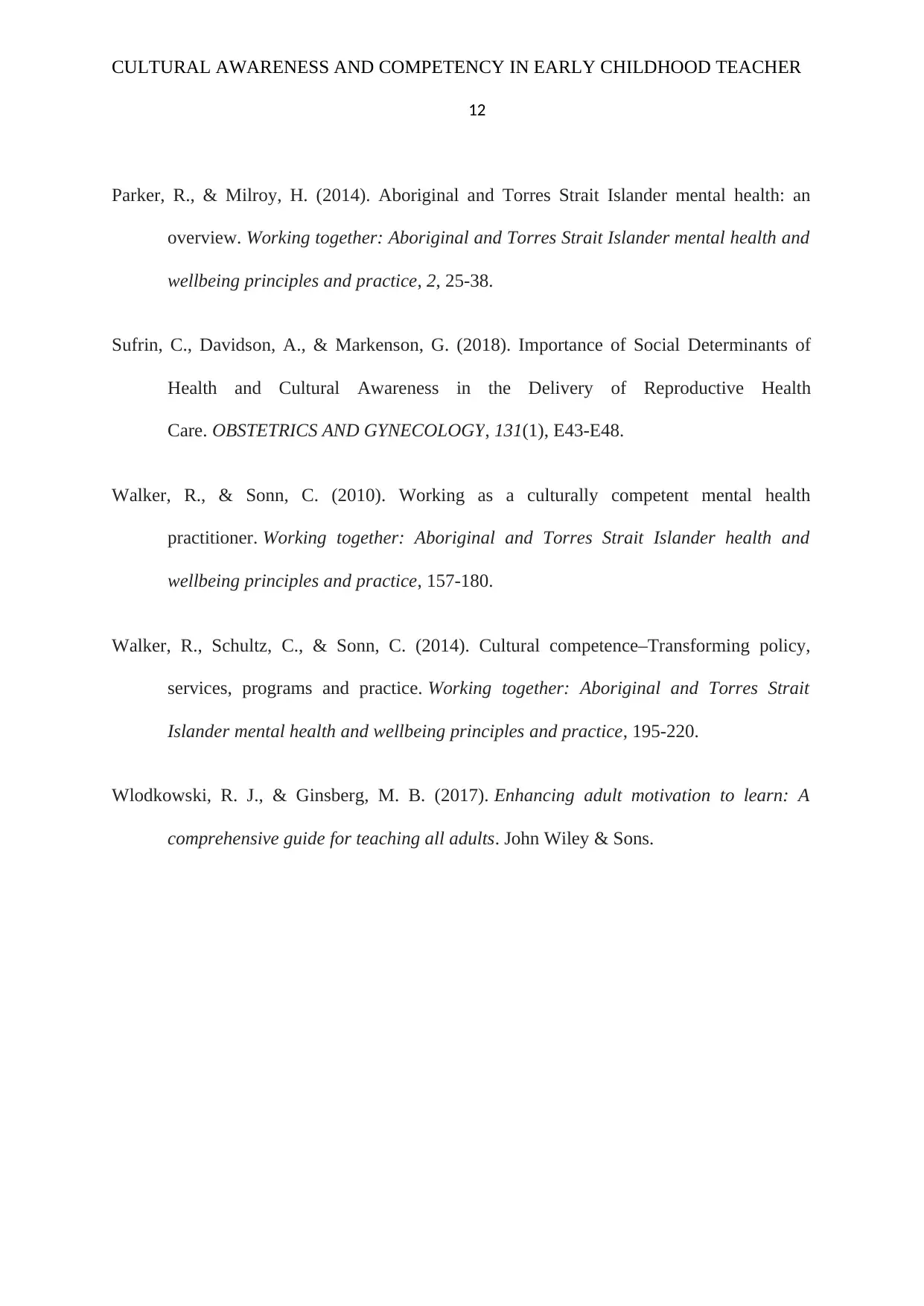
CULTURAL AWARENESS AND COMPETENCY IN EARLY CHILDHOOD TEACHER
12
Parker, R., & Milroy, H. (2014). Aboriginal and Torres Strait Islander mental health: an
overview. Working together: Aboriginal and Torres Strait Islander mental health and
wellbeing principles and practice, 2, 25-38.
Sufrin, C., Davidson, A., & Markenson, G. (2018). Importance of Social Determinants of
Health and Cultural Awareness in the Delivery of Reproductive Health
Care. OBSTETRICS AND GYNECOLOGY, 131(1), E43-E48.
Walker, R., & Sonn, C. (2010). Working as a culturally competent mental health
practitioner. Working together: Aboriginal and Torres Strait Islander health and
wellbeing principles and practice, 157-180.
Walker, R., Schultz, C., & Sonn, C. (2014). Cultural competence–Transforming policy,
services, programs and practice. Working together: Aboriginal and Torres Strait
Islander mental health and wellbeing principles and practice, 195-220.
Wlodkowski, R. J., & Ginsberg, M. B. (2017). Enhancing adult motivation to learn: A
comprehensive guide for teaching all adults. John Wiley & Sons.
12
Parker, R., & Milroy, H. (2014). Aboriginal and Torres Strait Islander mental health: an
overview. Working together: Aboriginal and Torres Strait Islander mental health and
wellbeing principles and practice, 2, 25-38.
Sufrin, C., Davidson, A., & Markenson, G. (2018). Importance of Social Determinants of
Health and Cultural Awareness in the Delivery of Reproductive Health
Care. OBSTETRICS AND GYNECOLOGY, 131(1), E43-E48.
Walker, R., & Sonn, C. (2010). Working as a culturally competent mental health
practitioner. Working together: Aboriginal and Torres Strait Islander health and
wellbeing principles and practice, 157-180.
Walker, R., Schultz, C., & Sonn, C. (2014). Cultural competence–Transforming policy,
services, programs and practice. Working together: Aboriginal and Torres Strait
Islander mental health and wellbeing principles and practice, 195-220.
Wlodkowski, R. J., & Ginsberg, M. B. (2017). Enhancing adult motivation to learn: A
comprehensive guide for teaching all adults. John Wiley & Sons.
⊘ This is a preview!⊘
Do you want full access?
Subscribe today to unlock all pages.

Trusted by 1+ million students worldwide
1 out of 12
Related Documents
Your All-in-One AI-Powered Toolkit for Academic Success.
+13062052269
info@desklib.com
Available 24*7 on WhatsApp / Email
![[object Object]](/_next/static/media/star-bottom.7253800d.svg)
Unlock your academic potential
Copyright © 2020–2025 A2Z Services. All Rights Reserved. Developed and managed by ZUCOL.





